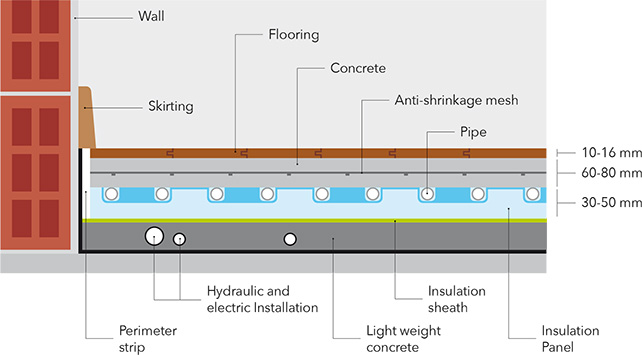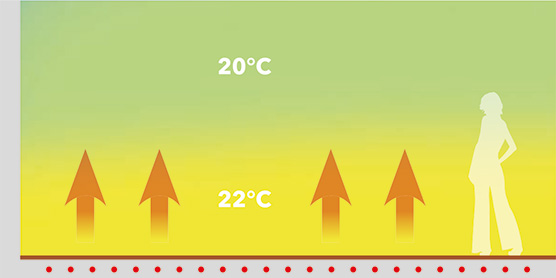CHECKING MATERIALS
All materials must be checked on delivery: the use or sale of materials by the purchaser constitutes acknowledgement of the agreed terms. If any defects are discovered during laying, it is advisable to put aside the damaged strips and, in serious cases, to immediately stop laying the material. The obligation of the supplier is limited to replacing the damaged material.
It is important to remember that all IDEAL LEGNO products are made in Italy to the highest standards and are controlled in compliance with ISO 9001:2000, the international Quality Management standard.
RECOMMENDATIONS BEFORE LAYING
Check that all external windows and doors have been installed and that all painting and masonry work etc. has been completed before laying. We can say that laying the wooden floor is the last job to be done before fitting the doors and bringing in the furniture.
Keep the boxes containing the parquet flooring in a clean dry place. Only open the boxes at the time of laying the floor, checking that the room temperature is at least 15°C and the relative humidity of the air is 45 – 60%.
The sub-floor must be protected from humidity and condensate formation. Check that the humidity of the floor screed does not exceed 2% for concrete screeds and 0.4 % for anhydrite screeds.
The sub-floor must be level, compact and clean without any surface dust. In the event of existing floor coverings (i.e. ceramic tiles, marble etc.), carefully prepare suitable surfaces and, if necessary, they should be “roughened” to provide suitable adherence conditions for the adhesive. Do not lay on surfaces with old adhesive present. If under-floor heating is present, make sure that the temperature of the heating fluid is about 30-35°C so that the temperature on the floor surface will not exceed 24°C. Strictly follow the correct procedures when laying flooring over this particular heating system.
LAYING INSTRUCTIONS
When laying, take strips from different boxes at the same time. Use only bi-component adhesives or those free from water, specifically designed for semi-finished parquet flooring. Apply the adhesive all over the surface of the sub-floor with a toothed spatula, following the manufacturer’s instructions. Leave a gap of at least 0.5 cm beside walls in order to allow the natural movement of wood. Avoid leaving adhesive along the edges of the sides and end pieces of joints. Immediately clean any adhesive marks with an appropriate cleaner for semi-finished parquet flooring. If cleaning is delayed, the adhesive may dry and then it will be difficult to remove, causing the risk of damage to the floor. Attention, do not apply scotch-tape on the wood-floor, it could damage the varnish.
DISPOSAL PROCEDURES
Any scraps, packaging and residual materials must not be discarded in the environment but must be taken to the appropriate public disposal centres in compliance with statutory provisions.
INSTRUCTIONS FOR LAYING OF WOOD FLOORING ON UNDERFLOOR RADIANT HEATING AND COOLING
Radiant flooring is an underfloor heating and cooling system with low temperature water that circulates in piping embedded in the cement layer to heat and cool spaces. Heat is transferred from the piping to the floor creating a radiant unit. This type of underfloor heating system is the one which provides as near as possible the ideal temperature curve as it generates a slightly warm temperature on the ground which becomes cooler as you go up. At head height there is an improved feeling of comfort.
With traditional heating systems floors are cold to the touch; with radiant systems the floor has a warm, pleasant temperature to the touch.
This system can be used in all seasons combined with a system to cool the circulating liquid which then cools the environment through the floor.
The standard of reference for underfloor heating systems for residential buildings and offices is the UNI EN 1264. The standard defines the project requirements so that the systems are correctly designed and installed respecting energy saving, thermal efficiency and comfort criteria.
ENERGY SAVING
A number of studies carried out on different heating systems have shown that the use of low temperature underfloor heating systems can produce energy saving of 35% compared to traditional systems.
The convenience of a heating screed system compared to other heating systems lies in the fact that it uses a relatively low temperature fluid (30°-35°C) with a working surface temperature of 22/24°; this generates good working efficiency, excellent heat uniformity and energy savings.
Such low delivery temperatures combined with solar panels and condensing boilers provide significant energy savings. Nowadays, thanks to new technologies, radiant panel heating offers an increased feeling of comfort, uniform and constant temperatures in the different rooms.
AESTHETIC ADVANTAGES
This system eliminates the presence of radiators so the entire wall space is available; it also eliminates marks and dust lines behind the
radiators and cold air currents generated by radiators.
SHORT INSTRUCTIONS FOR THE INSTALLATION OF A RADIANT SYSTEM
Before installing a radiant system all external windows and doors, and frames of inside doors must already be installed, plastering must be finished and the electrical system completed.
Electrical and sanitary systems are usually installed on the concrete floor slab smoothed with lightweight material on top of which the insulation panels are installed (on the ground floor we recommend laying a anti-humidity bituminous sheath before installing the systems).
Before laying the insulation panel it is useful to apply a perimeter strip along all vertical surfaces, i.e. walls or columns, to allow for thermal expansion of concrete which tends to increase in volume when heated by the coils. If the spaces are larger than 40-50 m2 expansion joints must be foreseen. At this point project instructions must be followed: the pipe must be laid (pipe size 10 is usually recommended) and covered by a screed of at least 60-80 mm; this provides improved thermal efficiency and heat uniformity on the surface.
An insufficiently thick screed would transfer too much concentrated heat to the wood floor increasing any cracks.
The screed must be prepared according to the instruction of the manufacturer of the radiant system in order to obtain the best compactness and thermal conductivity characteristics (compact throughout its thickness and with sufficient surface hardness); consolidation operations such as shaving and smoothing are not recommended. The application of a suitable “primer” is recommended to improve the adhesion of the adhesive only if the screed tends to produce dust.
The delivery temperature of the fluid that circulates in the underfloor pipes must not be higher than 30°-35°C. We recommend installing a safety probethermostat to measure the water delivery temperature and block the pump in order not to damage the wood floor if the temperature goes above the set limit of 45°-50°.

INSTRUCTIONS FOR LAYING OF WOOD FLOORING ON UNDERFLOOR RADIANT HEATING AND COOLING
LAYING THE WOOD FLOORING
External doors and windows should be installed before starting-up the system and the walls should also be decorated. Please note that the laying of a wood floor is the last job that should be done before mounting inside doors and furniture.
In principle all wood floors, especially multi-layer ones are suitable for laying on heated screeds as long as the elements are made of stable wood and have stable dimensions.
For improved heat uniformity and thermal insulation we recommend laying the wood floor with two-part adhesives.
The heating must be switched on for at least 3 weeks before laying the wooden flooring, whatever the season. The system must not however be switched on before the natural maturing of the screed and in any case not before 28 days from the installation. The temperature of the system must be gradually increased until maximum operating temperature is reached; that temperature must then be maintained for 10 days giving air to the premises. The system must be cooled by gradually reducing the temperature. The system must be switched off at least 3 days before laying the wood floor. The humidity of the screed must be checked before laying the wood flooring: the level must be below 1.5%. Humidity must be measured using a carbide hygrometer in a point that will not damage the underfloor system. This procedure must be carried out to make sure that the screed will not transfer humidity to the wood flooring.
This is all for the laying of prefinished varnished floors.
As regards the laying of traditional flooring and prefinished pre-sanded flooring once the adhesive is dry (about eight days for the adhesive to cure) the heating system must be gradually switched on for about 5-8 days to allow the wood floor to settle and stabilise. Once the system has been switched off the floor must be immediately sanded and varnished.
In our opinion the laying of floating or raised floors on heating systems is more complicated as the wood flooring and sub-layer are not in direct contact with the screed and this leads to a reduction in the thermal efficiency of the heated floor. Please note that wood flooring is usually laid with a synthetic sub-layer about 25 mm thick (even better if acoustically insulating), corrugated board or other suitable material.
In all cases, in winter, once the floor has been installed the heating must not be switched on for at least a week. The temperature must be gradually increased by 5° per day in order not to create great differences in temperature for the floor.
UNDERFLOOR COOLING SYSTEM
The water that circulates in the system has a temperature of 15-18°C and the critical element is the dew point (condensation). Consequently the measurement of ambient humidity and its control is decisive for the stability of the wood flooring. As already mentioned for underfloor heating systems, the ideal humidity level should be between 45 and 60%. Electronic control units and ambient thermostats connected to multi-zone humidifying/dehumidifying systems must be installed to constantly monitor the humidity inside the house to avoid the formation of condensation on the floor.
COMMENTS
Wood is a natural live material which tends to acclimatise to different environmental conditions therefore it “always” tends to move. It is always useful to take into account that over a long period of time small alterations, slight expansion or shrinkage may occur. To avoid the occurrence of these phenomena in so far as possible it is advisable to keep ambient humidity under control.


